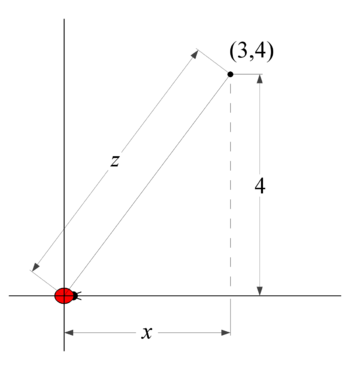Difference between revisions of "009A Sample Final A, Problem 9"
Jump to navigation
Jump to search
m |
m |
||
| Line 34: | Line 34: | ||
!Step 3: | !Step 3: | ||
|- | |- | ||
| − | |'''Evaluate and Solve:''' When the bug is at the origin, we have <math style="vertical-align: 1%;">x=3</math>. By the Pythagorean Theorem, <math style="vertical-align: 0%;">z=5</math>. Based on our drawing, our variable <math style="vertical-align: 0%;">x</math> is actually <u>''decreasing''</u> at a rate of <math style="vertical-align: | + | |'''Evaluate and Solve:''' When the bug is at the origin, we have <math style="vertical-align: 1%;">x=3</math>. By the Pythagorean Theorem, <math style="vertical-align: 0%;">z=5</math>. Based on our drawing, our variable <math style="vertical-align: 0%;">x</math> is actually <u>''decreasing''</u> at a rate of <math style="vertical-align: 0%;">30</math>, so we should really write <math style="vertical-align: -21%;">dx/dt=-30</math>. We now simply plug in to the result of our implicit differentiation to find |
|- | |- | ||
| <math>\frac{dz}{dt} = \frac {3}{5}\cdot(-30) = -18.</math> | | <math>\frac{dz}{dt} = \frac {3}{5}\cdot(-30) = -18.</math> | ||
Revision as of 09:37, 29 March 2015
9. A bug is crawling along the -axis at a constant speed of .
How fast is the distance between the bug and the point changing
when the bug is at the origin? (Note that if the distance is decreasing, then you should have a negative answer).
| Foundations: |
|---|
| Like most geometric word problems, you should start with a picture. This will help you declare variables and write meaningful equation(s). In this case, we will have to use implicit differentiation to arrive at our related rate. In particular, we need to choose variables to describe the distance between the bug and the point , which we can call . By the given information, we can consider the position on the -axis simply as . |
Solution:
| Step 1: |
|---|
| Write the Basic Equation: From the picture, we can see there is a triangle involving both the bug and the point . From this, we can see that . |
| Step 2: |
|---|
| Use Implicit Differentiation: We take the derivative of the equation from Step 1 to find |
| or |
| Step 3: |
|---|
| Evaluate and Solve: When the bug is at the origin, we have . By the Pythagorean Theorem, . Based on our drawing, our variable is actually decreasing at a rate of , so we should really write . We now simply plug in to the result of our implicit differentiation to find |












